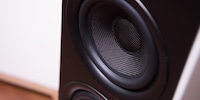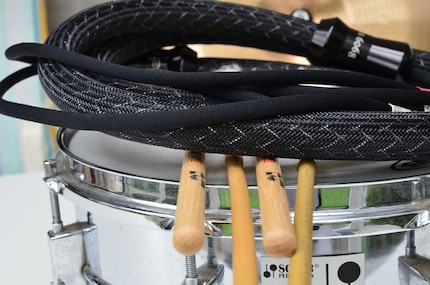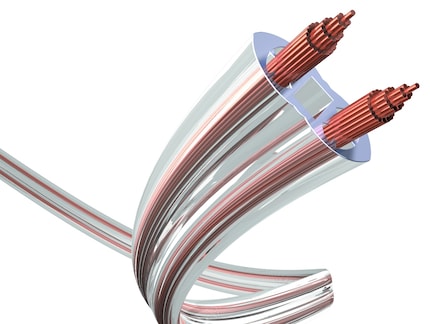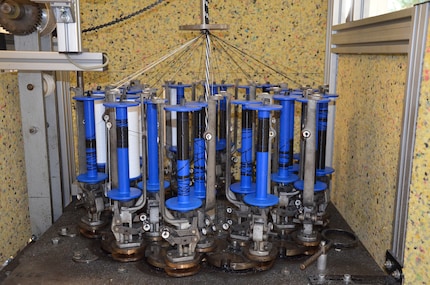
Background information
The art of positioning your loudspeakers
by Lothar Brandt

Cables are a hot topic in the hi-fi world. Some people spend tens of thousands of francs on models that are supposed to deliver mind-blowing sound, while others consider them a rip-off. We gather the facts.
"Cables make a huge difference, even if some people think it's a load of rubbish." This sentence didn't come from the mouth of the editor of a HiFi magazine that the most suspicious believe is capable of anything, venality, ignorance or even attempts at seduction. No, it was uttered by Wilfried van Baeden, director of Galaxy Studios in Belgium, where magnificent musical productions and spectacular film scores are produced. The massive 7500m2 complex is criss-crossed by around 200km of cable, much of which transmits signals between very high-end studio equipment.
Many HiFi fans - and even several manufacturers - completely agree with the beginning of the sentence, yet the "big nonsense" applies too. That's right, apart from the 'trolls' and 'haters' on the asocial media, many of you think there's absolutely no point in investing more than a few pennies in cables. Hang on, butterflies. Before some of you swoop down on your keyboards to write a properly corrosive comment, I'd like to make it clear that I don't want to fuel the debate, but rather encourage you to form your own opinion with my few basic principles.
Let me be clear: I believe that improving the sound of a HiFi system should start with optimising the position of the speakers and the acoustics of the room, not with buying high-end components and accessories at outrageous prices.
Only once these adjustments have been made can you think about which cables might replace the cheap versions. Speaker cables are a good start.
Two thin metal wires are enough to operate the doorbell at the front door. As long as they conduct electricity and the electrical circuit is engaged when someone presses the button, all is well. Using a doorbell wire to connect an amp to a loudspeaker? It's possible, but not ideal if we want our music to sound a bit better than our front doorbell.
Since high-fidelity moved beyond the days of old radios and the gramophone, every aspect of sound reproduction has been triturated at length. The connectors that link the various components have not been left out, as the field has continued to develop since the mid-70s. Many charlatans continue to swindle credulous HiFi enthusiasts in search of magic cables ready to fork out ten thousand francs or so.

But the field is not populated solely by crooks. There are also serious engineers who base their work on physical principles. Instead of reciting magic formulas on a full moon to improve sound, you can immerse yourself in the literature devoted to electrical engineering. There's a wealth of useful information on resistance, inductance and capacitance, the influences of geometry and materials, dielectric and electrical fields, and so on.lectrics and electric or magnetic fields, as well as the different requirements for loudspeakers and NF cables (these are the cables that connect a CD player to an amplifier, for example). The ideal for cables of all types is not to weaken the signal. In theory. In practice, there is no such thing as the ideal cable; everyone has their own type of filter. It's more a question of reducing losses as much as possible, and there are several ways of achieving this.
An amplifier supplies its loudspeaker outputs with the voltage that corresponds to the music. This voltage must be transmitted to the speaker terminals with as little loss as possible. The current passes through a cable, the length of which acts as a combination of switching elements that function as capacitors, coils and resistors, i.e. as the various circuit components. Capacitors have a capacitance, coils an inductance and resistors an impedance. Physicists call these parameters the properties of a cable, and they can be measured. So nothing to do with magic formulas.
Capacitance and conductance let some of the current seep into the cable, so to speak, while line resistance and inductance reduce some of the voltage. The impedance of loudspeakers and their frequency dividers depends on the frequency (also read the article Why watts alone tell you nothing). A loudspeaker or chassis begins to vibrate when its connections are subjected to a voltage (when induced). As a result of this electrodynamic impulse, the chassis induces an inductive reactance by vibrating back and forth which the amplifier must short-circuit.
The optimum cable should have zero impedance, capacitance and inductance values, which even an extremely short model struggles to achieve. This argument tips the balance in favour of active loudspeakers, which bring the amplifier much closer to the chassis. Passive loudspeakers, however, are the ones employed in high-fidelity, and amplifiers generally have to cross a distance of two to three metres.
Unfortunately, cable manufacturers try to obtain with low capacitance and high inductance, and vice versa. If they want to have a low line resistance and a high cable cross-section, they come up against the skin effect: high frequencies are now only transmitted through the superficial outer layers.
The whole art of making loudspeaker cables lies in how to keep everything as low as possible. You could compare this challenge to an engineer tasked with building an engine that has the highest possible performance and acceleration capability, but consumes as little as possible while still providing a comfortable ride. Moving towards one goal means moving away from another.
Some compromises that suit your amplifier and speaker combination relatively well are still possible. In particular, engineers will look for them in the geometry of the conductors. Complex interdependencies between thicker and thinner conductors, hollow cores, specific insulation materials and, of course, conduction materials themselvesmes (copper, silver or alloys) and even the way in which the plugs are fitted by crimping or soldering ("pins", "bananas" or "terminal strips").

Achieving such a high standard requires a huge amount of work and top-of-the-range materials, which explains why even serious manufacturers sometimes charge astronomical sums and expensive cables sometimes don't give the best results on certain amplifiers and/or speakers.

You're probably wondering what the difference really is. The answer is reminiscent of Radio Eriwan jokes: in principle yes, but .... Okay, there are differences, and I find that they're noticeable. But not everyone sees them as 'worse' or 'better'. It's more subtle than that, and it takes time. So if a cable has been designed specifically to boost treble or bass, it's best to be wary. The best cable is the one that allows you to listen to music for a long time, in a pleasant way, and to hear as many nuances as possible. I know, it's complicated.
Because this is a complicated subject, we've split our course into several articles, which doesn't mean we'll abandon you each time without giving you some practical advice. Start by positioning your speakers in the best possible way and check that you have connected them in phase to the amplifier (red to red, plus to plus, black to black or minus to minus). If the capacitors in your amplifier are already a few years or even decades old and the suspensions and diaphragms in your speakers are just as old, start by changing these decisive components according to your budget and musical tastes.
You can then experiment with your speaker cable (other connectors probably won't have as much effect). You'll find good two-by-three-metre models for 60 francs in the shops, which works out at 10 francs a metre. There are lots of manufacturers, some of whom offer half-price deals. And it's not really a scam at all.
I have been a journalist in the audio industry for over 30 years. I have a reputation as an avid music lover, a die-hard analog fan and an uncompromising critic of speakers. This surely has something to do with my lamentable attempts to play violin and drums beyond amateur status. For a while I lived and worked in Switzerland, my favorite country, where I love to return.
Interesting facts about products, behind-the-scenes looks at manufacturers and deep-dives on interesting people.
Show all